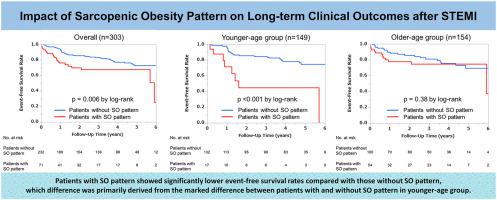Atherosclerosis ( IF 5.3 ) Pub Date : 2021-08-27 , DOI: 10.1016/j.atherosclerosis.2021.08.038 Ryosuke Sato 1 , Kozo Okada 1 , Eiichi Akiyama 1 , Masaaki Konishi 2 , Yasushi Matsuzawa 1 , Hidefumi Nakahashi 1 , Yugo Minamimoto 1 , Yuichiro Kimura 1 , Nobuhiko Maejima 1 , Noriaki Iwahashi 1 , Kiyoshi Hibi 1 , Masami Kosuge 1 , Toshiaki Ebina 1 , Kouichi Tamura 2 , Kazuo Kimura 1

|
Background and aims
Both low appendicular skeletal muscle index (ASMI) and specific abdominal fat composition [i.e., increased visceral to subcutaneous (V/S) fat ratio] have been associated with cardiovascular events. However, the combined impact of these 2 components on long-term outcomes remains unclear, especially in patients with ST-segment elevation myocardial infarction (STEMI).
Methods
In 303 patients with STEMI, ASMI and V/S fat ratio were assessed using dual-energy X-ray absorptiometry and abdominal computed tomography. Based on the criteria of the Asian Working Group for Sarcopenia and median of V/S fat ratio, sarcopenic obesity (SO) pattern was defined as low ASMI with high V/S fat ratio. The primary endpoint was composite outcomes of all-cause death, myocardial infarction, ischemic stroke, hospitalization for heart failure and unplanned revascularization.
Results
During a median follow-up of 3.9 years, primary endpoint occurred in 67 patients. Patients with an SO pattern showed significantly lower event-free survival rate compared with those without (p=0.006 by log-rank). Notably, when stratified by median age (67 years), this trend was particularly prominent in the younger-age group (p <0.001), but not significant in the older-age group (p=0.38). In the younger-age group, the multivariate analysis revealed that patients with SO pattern had a 2.97 (1.10–7.53) fold higher risk for primary endpoints compared with those without.
Conclusions
Low ASMI with high V/S fat ratio, or so-called sarcopenic obesity, was associated with poor prognosis after STEMI, particularly in younger-age patients. The combined assessment of skeletal muscle with abdominal fat distribution may help stratify the risk among patients with STEMI, rather than each component alone.
中文翻译:

肌肉减少性肥胖对 ST 段抬高型心肌梗死后长期临床结局的影响
背景和目标
低阑尾骨骼肌指数 (ASMI) 和特定的腹部脂肪成分 [即内脏与皮下 (V/S) 脂肪比率增加] 都与心血管事件有关。然而,这两个组成部分对长期结果的综合影响仍不清楚,尤其是在 ST 段抬高型心肌梗死 (STEMI) 患者中。
方法
在 303 名 STEMI 患者中,使用双能 X 射线吸收测定法和腹部计算机断层扫描评估了 ASMI 和 V/S 脂肪比。根据亚洲肌肉减少症工作组的标准和 V/S 脂肪比率中位数,肌肉减少性肥胖 (SO) 模式被定义为低 ASMI 和高 V/S 脂肪比率。主要终点是全因死亡、心肌梗死、缺血性卒中、心力衰竭住院和计划外血运重建的复合结局。
结果
在中位随访 3.9 年期间,67 名患者发生了主要终点。与没有 SO 模式的患者相比,具有 SO 模式的患者显示出显着较低的无事件生存率(p= 0.006,对数秩)。值得注意的是,当按中位年龄(67 岁)分层时,这一趋势在年轻组中尤为突出(p < 0.001),但在老年组中不显着(p = 0.38)。在年轻组中,多变量分析显示,与没有 SO 模式的患者相比,具有 SO 模式的患者的主要终点风险高 2.97 (1.10–7.53) 倍。
结论
具有高 V/S 脂肪比的低 ASMI,或所谓的肌肉减少性肥胖,与 STEMI 后的不良预后相关,尤其是在年轻患者中。骨骼肌与腹部脂肪分布的综合评估可能有助于对 STEMI 患者的风险进行分层,而不是单独评估每个组成部分。


























 京公网安备 11010802027423号
京公网安备 11010802027423号